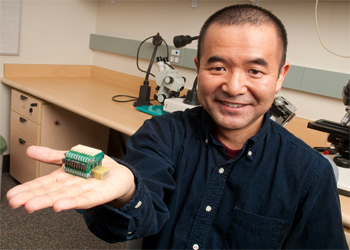
Phone: (403) 394-3998
e-mail: tatsuno@uleth.ca
Office: EP 1258
Lab: EP 1136
Research Interests
Dr. Tatsuno’s experimental research is aimed at understanding how REM and non-REM sleep contribute to memory consolidation. By recording multi-neuronal activity with hippocampal dependent and independent tasks, his laboratory investigates whether different types of memory benefit differently from REM and non-REM sleep or whether REM and non-REM sleep act serially and play complementary roles. His group also investigates decoding of neuronal activity during REM sleep, which will lead to decoding of dream content. Dr. Tatsuno’s computational research focuses on further development of information geometric method for multi-neuronal spike patterns. This approach, for example applied to spike data before and after the task, will provide further insights into changes in the connection weights due to memory reactivation and learning. In addition, to investigate how reactivation improves performance, he constructs computational models of cortical and subcortical regions.
Biography
Masami Tatsuno received his Ph.D. in Applied Physics from Waseda University , Japan . From 1999 to 2002, he was a postdoctoral researcher at RIKEN Brain Science Institute, Japan , where he conducted information geometric analysis of spike trains under the mentorship of Shun-ichi Amari. In order to acquire experimental skills to further his interest in neural computational principles, he joined the group of Bruce McNaughton at the University of Arizona in 2002. There, he conducted multi-electrode recording from various brain areas, and studied memory-trace reactivation during slow-wave and REM sleep and the fluctuation of cortical Up and Down states. In 2005, he was appointed as a research faculty of the University of Arizona. In 2009, he accepted a faculty position at the University of Lethbridge. In 2010, he received an iCORE Scholar Award from Alberta Innovates Technology Futures.
Degrees
- Ph.D. -Waseda University (Tokyo, Japan).
- M.Sc. -Waseda University (Tokyo, Japan).
- B.Eng. -Waseda University (Tokyo,Japan).
Books

M. Tatsuno Editor, (2015) Analysis and modeling of coordinated multi-neuronal activity, Springer Series in Computational Neuroscience, Springer (ISBN 978-1-4939-1969-7).
- State-of-the-art introduction of multi-electrode recordings and how they contribute to the understanding of hippocampal memory
- Overview of the modeling approach to hippocampal memory
- Presentation of hippocampal local circuits and hippocampal-cortical interactions
Recent Publications
- Tatsuno, M, (2016) Information-geometric analysis of neural signals, Ed. El Hady, Closed loop neuroscience, Elsevier (in press).
- Tatsuno, M, (2016) Sleep and memory, Experimental Medicine (Jikken Igaku), 34(7) (in press).
- Akaho, S, Higuchi, S, Iwasaki, T, Hino, H, Tatsuno, M, Murata, N. (2016) Graph structure modeling for multi-neuronal spike data, Journal of Physics: Conference Series, 699(1), pp. 12012-12019.
- Nie, Y, Fellous, JM, Tatsuno, M. (2014) Influence of external inputs and asymmetry of connections on information-geometric measures involving up to ten neuronal interactions, Neural Computation, 26(10), pp. 2247-2293.
- Noda, A, Hino, H, Tatsuno, M, Akaho, S, Murata, M. (2014) Intrinsic graph structure estimation using graph laplacian, Neural Computation, 26(7), pp. 1455-1483.
- Schwindel, CD, Ali, K, McNaughton, BL, Tatsuno, M. (2014) Long-term recordings improve the detection of weak excitatory-excitatory connections in rat prefrontal cortex, Journal of Neuroscience, 34(16), pp. 5454-67.
- Wilber, AA, Clark, BJ, Foster, TC, Tatsuno, M, McNaughton, BL. (2014) Interaction of egocentric and world centered reference frames in the rat posterior parietal cortex, Journal of Neuroscience, 34(16), pp. 5431-46.
- Y. Nie, JM. Fellous and M. Tatsuno, (2014) Information-geometric measures estimate neural interactions during oscillatory brain states, Frontiers in Neural Circuits, 8(11), doi: 10.3389/fncir.2014.00011.
- Gomez Palacio Schjetnan, A, Faraji, J, Metz, GA, Tatsuno, M, Luczak, A. (2013) Transcranial Direct Current Stimulation in Stroke Rehabilitation – A Review of Recent Advancements. Stroke Research and Treatment, 2013, 170256. dx.doi.org/10.1155/2013/170256
- Nie, Y, Tatsuno, M. (2012) Information-geometric measures for estimation of connection weight under correlated input. Neural Computation, 24(12), 3213-45.
- Navratilova, Z, Hoang, LT, Schwindel, CD, Tatsuno, M, McNaughton, BL. (2012) Experience-dependent firing rate remapping generates directional selectivity in hippocampal place cells. Front. Neural Circuits 6(6). doi: 10.3389/fncir.2012.00006
- Tatsuno, M. (2010) Sleep and learning – memory consolidation and memory-trace replay during sleep -, Japanese Journal of Sleep Medicine, 4(4), 483-88.
- Tatsuno, M. (2010) Multi-electrode recording from freely behaving animals and spike train analysis, Journal of Japan Neural Network Society, 17(3), 124-38.
- Johnson, LA, Euston, DR, Tatsuno, McNaughton, BL. (2010) Stored-trace reactivation in rat prefrontal cortex is correlated with down-to-up state fluctuation density, Journal of Neuroscience, 30(7), 2650-61.
- Tatsuno, M, Fellous, JM, Amari. S. (2009) Information geometric measures as robust estimators of connection strengths and external inputs, Neural Computation, 21(8), 2309-35.
- Tatsuno, M, (2009) Replay of behaviorally induced multi-neuronal spiking patterns during subsequent sleep, Seitai No Kagaku, 60(4), 285-94.
- Euston, DR, Tatsuno, M, McNaughton, BL. (2007) Fast-forward playback of recent memory sequences in prefrontal cortex during sleep, Science, 318(5853), 1147-50.
- Tatsuno, M, (2007) Memory replay and memory consolidation, Seibutsu Butsuri, 47(6), 367–77.
- Tatsuno, M, Lipa, P, McNaughton, BL. (2006) Methodological considerations on the use of template matching to study long-lasting memory trace replay, Journal of Neuroscience, 26(42), 10727-42.
- Tatsuno, M, Okada, M. (2004) Investigation of Possible Neural Architectures Underlying Information-Geometric Measures, Neural Computation, 16(4), 737–65.